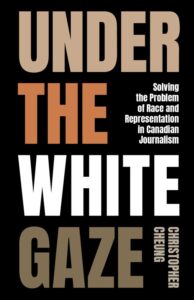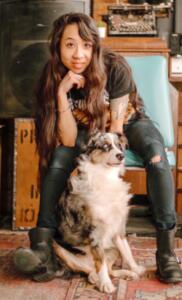News on the ‘four Ds of diversity’
Under the White Gaze: Solving the Problem of Race and Representation in Canadian Journalism
by Christopher Cheung
Vancouver: UBC Press/Purich Books, 2024
$24.95 / 9780774881111
Reviewed by Jessica Poon
*

Picture a quintessential Canadian. Do you see a mildly ruddy white man, guzzling a brewski and watching hockey, loudly declaring he doesn’t see colour? Perhaps there are Timbits and a toque. He probably bears some resemblance to a roommate I once had, a Purolator driver, partially estranged from his family, who subsisted on microwaveable dinners and was remarkably generous with sharing his beer. My former landlord described him as “so Canadian.” We were all Canadian, but apparently not equally so.
Under the White Gaze by Christopher Cheung, who has written about my favourite architectural phenomenon ever, is a precise exploration of how the “diversity reckoning” in journalism often functions as an ornamental topper with a finite quota. The book is also incredibly insightful in demonstrating how seemingly neutral language is often anything but. Cheung deftly explains the different types of reductive representation that ultimately leads to less nuance and persistent, unflattering stereotypes that only strengthen the widespread assumption that white is default.
Cheung identifies the “four Ds of diversity in Canadian journalism, when it comes to race, ethnicity, and culture:
“Darlings” – model minorities who are celebrated;
“Deviants” – people of colour who have their behaviour racialized, whether the behaviour is bad or perceived as bad;
“Damaged” – sad and suffering people of colour; and
“Delicious” – cultures for consumption.
It is said, often disingenuously, that all publicity is good publicity. I can think of numerous instances where this is demonstrably false. Similarly, not all positive representation is, upon scrutiny, genuinely positive representation. When journalists write feel-good stories about model minorities evincing a winsome ethos of working hard, there is the possibility of “pitting racialized people against one another,” as well as omitting contextual truths about how “different groups experience systemic racism differently.” If a well-intentioned, heartwarming story carries the unintended implication that “hard work is all it takes to lift people out of poverty and free themselves from marginalization,” is this representation genuinely beneficial, or likely to strengthen a reader’s potentially pre-existing discrimination toward a racialized group?
Just as there are “darlings,” there are “deviants,” written about in such a way that is “often connected to a larger moral panic about how they’re engaging in unacceptable behaviour that threatens the well-being, basic values, and interests of society. A solution might even be presented, such as limiting expression or cultural expression.” Cheung points out how large numbers of migrants are frequently described in ways that seem to liken “migration … to natural disasters because it tells audiences to understand them as such.” Words such as “surge” and “flood” and “waves” all encourage the tacit belief that migration is something to fear, so here’s an idea: stop using those words to describe migration.
(As an aside—a while ago, a friend of mine was telling me about all the women he was either dating, or trying to date. As you might expect, the dates were largely mediocre and exactly my gossip catnip. He did not specify the ethnicity of any of these women, until he began talking about a Japanese woman. “Are the other women white?” I asked him. While it is true he hadn’t said anything remotely derogatory, it is also true that the only woman whose ethnicity was specified, was a racialized person. I mean, why wouldn’t he, as a white person who is considered an average Canadian? I was neither trying to attack or police his language choices. All I wanted was to bring attention to what he was bringing attention to and when he chose to do so.)
Vancouver-based Cheung, who writes for The Tyee, explains instances where race, in fact, is not of paramount importance: “If a Japanese Canadian teenager wins a math competition, their ethnic background shouldn’t be mentioned if the story of the participation has nothing to do with their background. If a migrant is accused of a crime, the history of their time in Canada might be relevant to the story; however, journalists should be careful about how they frame the story, to avoid racializing the alleged crime.” It is altogether too easy for facts to become unduly emphasized and subsequently sensationalized, to the point where race becomes not only associated, but equated with criminal behaviour. Doubtless, this is harmful.

It’s also worth nothing that race, more often than not, is very much intersectional, which I realize is something of a polysyllabic bogeyman of a word that the right-wing media finds easy to dismiss as being too “woke.” At its most basic, all intersectionality, “describes the ways in which social categories—such as race, class, gender, sexuality, age, ability, citizenship status, religion, appearance, and more—combine and shape how a person experiences life, from privilege to oppression.” For a simple example, being rich, heterosexual, and Asian would be vastly different than being poor, queer, and Asian. Race is not the only germane category. Intersectionality acknowledges this multiplicity of social categories; it is nothing to fear.
Cheung acknowledges that journalists confronted with frenetic deadlines, will not always be in a position to prioritize integrity and impeccable word choices; it is an ongoing challenge in a world where clickbait takes precedence. He mentions his own journalistic shortcomings in the past, which I found endearing and humanizing, proving that not only is progress possible, it is absolutely vital.
When detailing an article he wrote about Duffin’s Donuts, well-known for a wide-ranging menu going well beyond donuts, he explains
The line I used to describe the extensive offerings: “a map of migration on a mosaic of a menu.”
I wrote the story because I love doughnuts, but also because locals like to describe racialized businesses with eclectic menus like Duffin’s as “random.” Through my story, I wanted to show that as people move around, they pick up flavours and recipes from each place they spend time in and bring them along with them.
Cheung may well be literally the only person I’ve ever read who agrees with me that the word “random” is overused and misused. He does Duffin’s justice.
Cheung also astutely points out that journalists are guilty of fetishizing hole in the wall restaurants in ways that are full of adulation and condescension tend to gloss over why a restaurant might be in a seemingly undesirable location (spoilers: the answer is usually unaffordable rent). Cheung writes “I hope journalists will stop pretending as if they’re Columbus discovering the New World every time they find a new restaurant.” In Toronto, there is a bar called Hole in the Wall. It is very narrow, darkly lit, a fine place for a first date with someone you probably shouldn’t have asked out while you were walking your dog and on the hunt for a rebound, but let me tell you, it is not a hole in the wall at all, but a bougie place banking on the romanticized appeal of a grotty hidden gem of an “ethnic” place, while actually being a rather bougie place to get pizza.
Cheung carefully explains that a news story that covers one of the four Ds is not inherently bad or wrong; rather, it’s worth observing whether racialized people are written about with depth and nuance and/or whether it corroborates stereotypes without explanation. He includes a quote by actress Constance Wu, who believes that instead of blanket avoidance of stereotypes, it would be far more propitious to use “truly great actors who can humanize these stereotypes, so rather than being reductive, they’re expansive.”
Cheung’s debut book is lucid, precise, and insightful. He writes sensitively about the job hazards of being a journalist, the italicization of non-English words that, the “explanatory comma,” a reluctance from journalists to use the word “racism,” and his belief that “I don’t think journalism students should be allowed to graduate without an education on puns.” He writes about the quandary of whether to include an interviewee’s words verbatim, if the interviewee espouses beliefs or uses outdated language that may be misconstrued as the journalist’s endorsement, or as propagating “essentialist depictions.” There’s a wealth of information and insight here, which is structured in thoughtfully alliterative chapter titles like “Of Deliciousness and Damage” and “Of Silence and Shutdowns.” I’m tempted to quip that I can’t wait to ask a white person to read this, but in truth, everyone, of any and all overlapping identities, would benefit from Cheung’s clearly communicated observations and suggestions.
I learned so much from this book, which filled me with more hope than outrage. Under the White Gaze is elucidating without ever being didactic and genuinely enjoyable to read; quite frankly, I can’t do it justice, but I certainly tried. I will read anything Christopher Cheung writes.

*

Originally from East Vancouver, Jessica Poon is a writer, former line cook, and pianist of dubious merit who recently returned to BC after completing a MFA in Creative Writing at the University of Guelph. [Editor’s note: Jessica Poon recently interviewed Sheung-King, and has reviewed books by Anne Hawk, Pat Dobie, Giana Darling, Umar Turaki, Katrina Kwan, Jane Boon, Terese Svoboda, Maia Caron, Wendy H. Wong, Andromeda Romano-Lax, Sarah Leipciger, Katrina Kwan, Shelley Wood, Richard Kelly Kemick, Elisabeth Eaves, Rajinderpal S. Pal, Keziah Weir, Amber Cowie, Robyn Harding, Roz Nay, Anne Fleming, Miriam Lacroix, Taslim Burkowicz, Sam Wiebe, Amy Mattes, Louis Druehl, Sheung-King, Loghan Paylor, Lisa Moore (ed.), Sandra Kelly, and Robyn Harding for BCR]
*
The British Columbia Review
Interim Editors, 2023-26: Trevor Marc Hughes (non-fiction), Brett Josef Grubisic (fiction and poetry)
Publisher: Richard Mackie
Formerly The Ormsby Review, The British Columbia Review is an online book review and journal service for BC writers and readers. The Advisory Board now consists of Jean Barman, Wade Davis, Robin Fisher, Barry Gough, Hugh Johnston, Kathy Mezei, Patricia Roy, and Graeme Wynn. Provincial Government Patron (since September 2018): Creative BC. Honorary Patron: Yosef Wosk. Scholarly Patron: SFU Graduate Liberal Studies. The British Columbia Review was founded in 2016 by Richard Mackie and Alan Twigg.
“Only connect.” – E.M. Forster
One comment on “News on the ‘four Ds of diversity’”